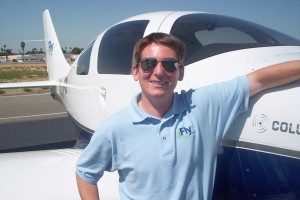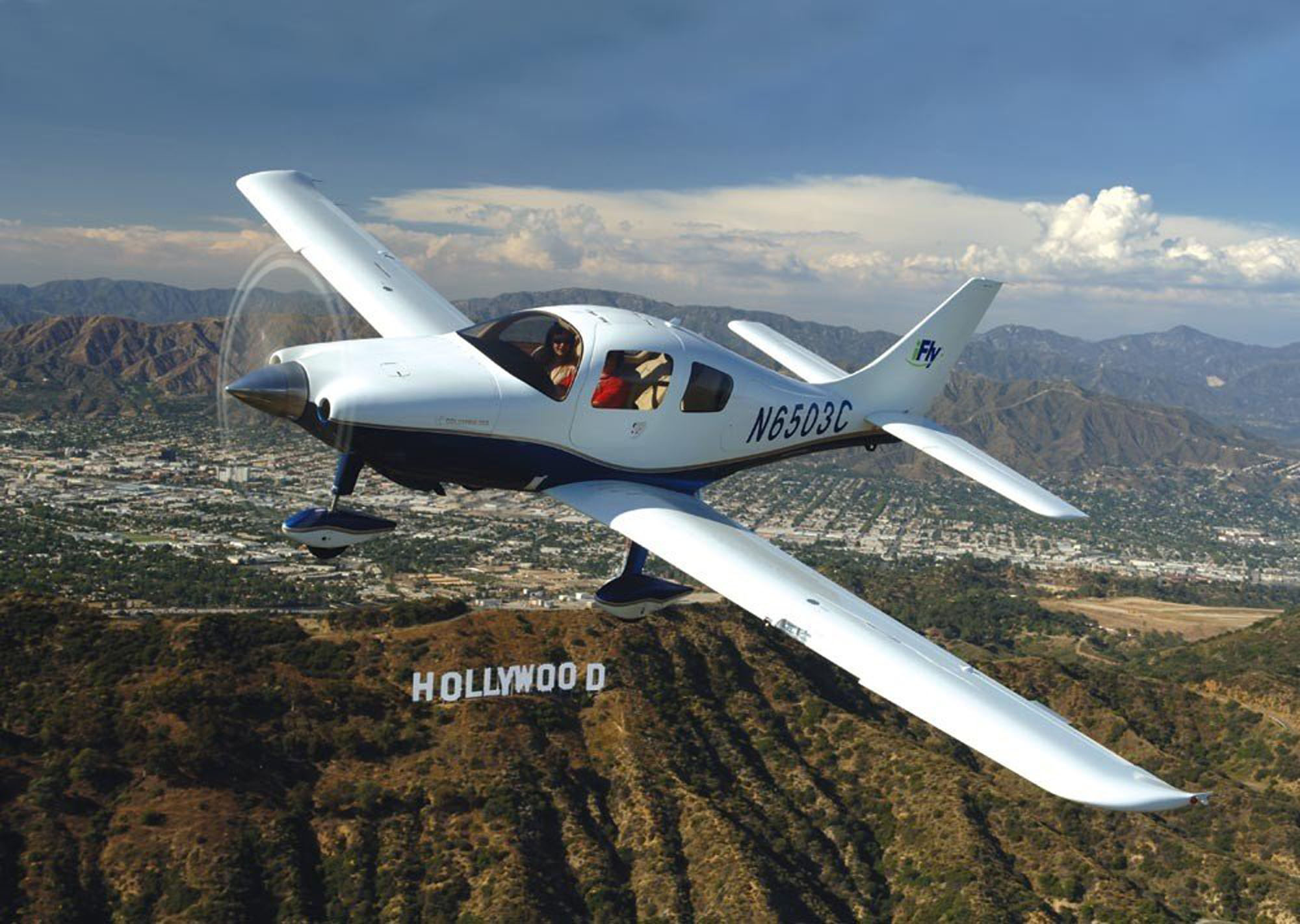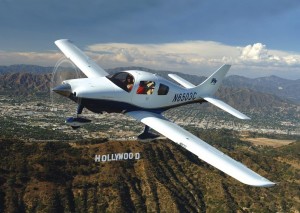By Fred “Crash” Blechman
There I was in a Cadillac, with Tom Cruise, looking down at the Ronald Reagan Presidential Library in Simi Valley. Perhaps I should explain. It wasn’t really a Cadillac. It was an airplane I’ve dubbed “The Cadillac of the Skies”—a Columbia 350. And it wasn’t Tom Cruise; it was Scott Marti, who I think looks like Tom Cruise did (including the Ray-Ban sunglasses) 20 years ago, in the movie “Top Gun.”
I was on a demo flight with iFly, the world’s first exclusive aero club. For only $70 an hour (plus fuel), members can fly unlimited hours in a Columbia 350—one of today’s most desirable next-generation personal aircraft. More on iFly later in this story, but let’s go flying!
We met at Skytrails Aviation, on the south end of Van Nuys Airport. Joshua Chaiton, iFly vice president, member care, and Anthony Newcomb, membership director, let me spend some time in the left front “pilot in command” seat of the four-passenger Columbia 350 on static display, while the plane I was going to fly was arriving from another flight.
I admit to being somewhat overwhelmed. This 36-foot wingspan, tricycle, fixed-gear aircraft is eye candy, inside and out. Manufactured in Bend, Ore., the 350 structure is made of composite materials, with a full leather interior. Two large LCD Garmin G1000 multi-function displays dominate the instrument panel. Loaded with optional equipment, iFly’s 350s include air conditioning and a navigation suite.
The Columbia 350 has a cruising speed of 191 knots at 8,000 feet, a maximum range of 1,320 nautical miles, with a useful load of 1,100 pounds, and stalls at only 57 knots. It includes top-wing speed brakes for controlled fast descent.
Pistol-grip side controllers are directly connected with control rods to the ailerons and elevator. Unlike some side controllers that require push-pull for elevator operation, these controllers pivot on a single bottom point, like a computer simulator joystick. The rudder pedals use toe brakes, and the front wheel is self-castoring, 60 degrees each side of center, using the rudder pedals or brakes. This was no Piper Cub!
Soon, Scott Marti, formerly the chief flight instructor at Columbia Aircraft, arrived in a Columbia 350. Scott, 29, earned his private pilot license only two months after his first flight. He now has 2,500 hours, and is rated for single and multi-engine, as well as qualified as an instrument instructor.
I climbed into the right front seat and got strapped in, while Scott turned on the Garmin G1000 LCDs, started the engine, and showed me some of the many displays. It was like having about 100 flight and engine instruments, as well as a large full-color GPS. No wonder the Columbia 350 has two independent batteries and electrical busses. And no wonder iFly membership includes flight training specifically in one of its Columbia 350s!
Scott showed me the various buttons and switches for the displays, air conditioning and navigation, as we taxied out to Runway 16L for a takeoff to the south. When cleared by the tower, he used the full power of the Continental IO-550-N 310-horsepower, normally-aspirated engine, and 2,700 rpm to the three-bladed Hartzell propeller. We lifted off the runway in about 1,200 feet, rotating at 70 knots, then climbing at 106 knots, as I took the controls and turned to the west, following the Ventura Freeway. The visibility was fair, but the air was very bumpy.

Scott Marti, formerly chief pilot for Columbia Aircraft, took me on an iFly demo flight in the Columbia 350.
I found myself holding a lot of right pressure on the controller, until I began using the four-way toggle electric trim-tab switch. As we reached the west end of the valley, I turned north and then west to the Simi Valley, where I circled the Reagan Library, and then headed out past Camarillo and Santa Paula airports, to the Ventura Fairgrounds at the Pacific Coast, cruising along at about 160 knots indicated. To the north was a raging fire, with a strong Santa Ana wind driving the smoke out over the ocean.
Turning back east, I flew south of the Ventura Freeway, right over the Camarillo Airport, past Thousand Oaks and into the south end of the San Fernando Valley, where we used above-wing air brakes in the turbulent air as we descended into the Van Nuys Airport traffic pattern from the west. Scott took the controls and was cleared for a short approach to Runway 16R, which he executed to a smooth landing.
iFly
Charles Lindbergh’s work and achievements helped propel general aviation’s initial success. Today, Erik Lindbergh, iFly cofounder, continues his grandfather’s spirit of innovation. He’s already established his own place in aviation history through the X-Prize Foundation, which promotes the future of space travel.
Federal Aviation Administration data indicates that most personal aircraft sit unused 80 percent of the time. In too many cases, privately owned personal aircraft are underutilized, depreciating assets. iFly introduces a smarter way to fly the next generation Columbia 350. For about half the cost of traditional sole ownership of a new Columbia 350, or for the cost to own and fly a 30-year-old Cessna 182, iFly members enjoy access to a fleet of identically equipped Columbia 350s and iFly takes care of all of the responsibilities of ownership.
Aircraft ownership comes with a number of responsibilities that many buyers overlook when deciding to purchase an airplane. Things like insurance, aircraft maintenance and repairs, cleaning, and paying fees for hangars or tie downs, all lie beyond the initial cost of acquiring an airplane. Through market research, iFly determined that these responsibilities were a primary source of dissatisfaction with the personal flying experience among many aircraft owners. So they got rid of them.
iFly members enjoy all of the benefits of access to a fleet of identically prepared Columbia 350s without any of the responsibilities of ownership. Members simply book their aircraft, show up and fly, then walk away when they’ve completed their trip. iFly reconciles the reality of personal flying with the dream.
The sentiment of iFly and Columbia Aircraft is, “The best way to make an aircraft safer is to train those who fly it better.” Columbia Aircraft has long been a leader in personal aviation pilot training. The company has established extremely high training standards for all who buy their aircraft. Columbia Aircraft’s enviably low accident record reflects this commitment.
iFly has adopted this commitment to exceptional flight training. The company requires all members to complete the same three-day training program as a traditional Columbia Aircraft buyer, as well as recurrent training every six months. iFly conducts all of its member flight training from its bases of operation at airports located conveniently to its members. Additionally, the cost of membership covers all initial and recurrent training.
Aircraft availability is the key to member satisfaction. Anyone considering this type of program likely has concerns, such as, “Will aircraft be available when I want to fly?” iFly recognizes this concern and has established practices to maximize aircraft availability for its members. The company maintains an industry-low 4:1 member-to-aircraft ratio. Most fractional ownership programs maintain ratios of 8:1 or even 12:1. Traditional flying clubs are much higher than that—not to mention the fact that you won’t find a fleet of Columbia 350s in any traditional flying club.
Beyond the low member-to-pilot ratio, iFly seeks to maximize aircraft availability through active maintenance of the aircraft in its fleet to minimize downtime, a single-make fleet that allows any member pilot to fly any aircraft in the fleet, and a simple-to-use online aircraft reservations system. Through these practices, it’s possible that iFly members enjoy even greater access to aircraft than do traditional sole owners.
iFly currently operates from six Southern California airports: Van Nuys, Santa Monica, Torrance, Long Beach, John Wayne International and Carlsbad.
For further information, call 1-866-GO-FLYING or visit [http://www.iflysmarter.com]. Fred “Crash” Blechman’s two flying books, “Bent Wings – F4U Action & Accidents: True Tales of Trial & Terror!” and “Flying With the Fred Baron,” are available at [http://www.amazon.com] or [http://www.bn.com].












